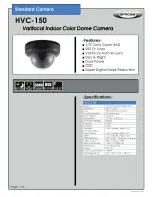
PEM300D
V. 02 – 27/11/2013
4
©Velleman nv
4.
Mounting Location
•
Make sure there are no obstructions between the transmitter and the
receiver (trees, bushes, clotheslines etc.).
•
Avoid strong light (sun, car headlights, etc.) shining directly on
transmitter or receiver. When strong light stays in the optical axis for a
long time, it does not cause malfunction but will reduce the product life.
•
Do not install the units where they may be affected by dirty water or
direct sea spray.
•
Do not install the units on unsteady surfaces.
•
The receiver has to be placed within the detection range (30m/100ft)
and the spread of the beam (
∅
0.9m/3ft at 30m/100ft) of the
transmitter.
•
Install the sensors at a height of 0.8 to 1m (± 3ft), the ideal height to
capture human passers-by.
•
With the sensor block adjustments ([7] and [9] in the picture above), a
large variety of mounting combinations are possible. See "6. Alignment"
for guidelines.
5.
Wiring / Contacts
•
Terminal connection 1 is the power 10 to 30V DC + line on both units.
Terminal connection 2 is the power 10 to 30V DC - line on both units.
The power lines need to be connected to these terminals.
•
Terminal connections 6 and 7 form a tamper output ; they are
connected through a dry contact relay.
When the cover is taken off, there is no contact.
No wires need to be connected to these terminals.
•
On the receiver, terminal 3 is normally connected to terminal 4 and in
the event of detection, contact with terminal 4 is broken and contact
with terminal 5 is established.
It depends on how your control panel works if you need to connect
either terminals 3 and 4 or terminals 3 and 5 to the control panel.
Maximum wiring distance
When two or more sets are connected, the maximum cable length is as
shown above divided by the number of sets.
Voltage
Wire / size
12V
24V
AWG22
0.33mm²
m
ft
320
1050
2800
18000
AWG20
0.52mm²
m
ft
550
1800
4800
12750
AWG18
m
800
7200





































